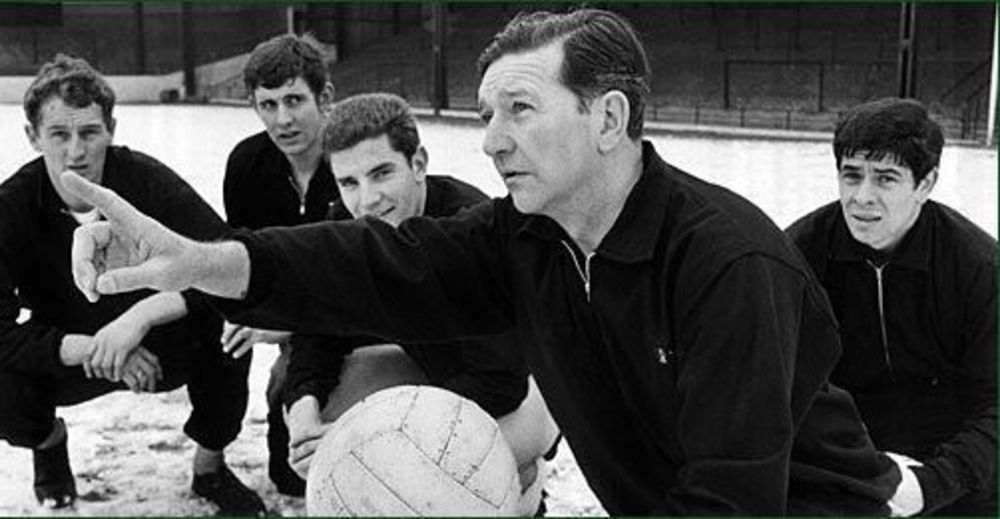
Of course, the most famous Southern League upset which gets an airing every year is the Hereford United victor over Newcastle United in the Edgar Street mud.
COLCHESTER UNITED were members of the Southern League until 1951 when they were elected to the Football League.
But the Essex outfit had a tremendous run in the FA Cup in 1947/48 which no doubt helped in their election bid.
The U`s overcame a Fourth Qualifying Round derby with Chelmsford City 3-1 before shrugging off another non-League side, Banbury Spencer, 2-1.
Player-manager Ted Fenton`s side were handed a third successive home draw in the Second Round against Third Division Wrexham and edged that 1-0.
The U`s were once again drawn out first for the Third Round – the furthest the club had been in the competition - and this time faced First Division Huddersfield Town.
The Terriers were struggling in the First Division at the time, although they still possessed one of the top players of the time in inside left Peter Doherty, who won 16 caps for Ireland and went on to manage Northern Ireland from 1951 until 1962.
Despite his silky skills, a late goal from Bob Curry caused a massive cup upset.
Remarkably, Colchester were handed a fifth successive home tie and, after seeing off Huddersfield, their fans were optimistic of going even further when Second Division Bradford Park Avenue were drawn out of the hat as their next opponents.
Avenue were a mid-table Second Division side who included the likes of legendary future West Ham United manager Ron Greenwood in defence, and Billy Elliott on the wing, a player who cost a then-massive £23,000 three years later in a move to Burnley. He later won 5 caps for England at a time in the early 1950s when the country possessed a plethora of star wide players.
Colchester edged through by the odd goal in five to reach the heady heights of the Fifth Round.
This time, however, the draw gave the U`s their first away tie and they were paired with First Division Blackpool at Bloomfield Road.

Fenton (left), a former West Ham and England half-back, had come up with an `M Plan` designed to snuff out Blackpool`s star forwards such as Stanley Matthews and Stan Mortensen.
Despite conceding an early 4th-minute goal, Colchester recovered and caused the Seasiders problems.
But Blackpool’s class inevitably told in the end and after they had doubled their lead on the half-hour mark, three further goals immediately after half-time put them in firm control of the tie and ended Colchester’s dream run.
Blackpool went all the way to the final that season, beating Fulham 2-0 in the quarter-finals and Spurs 3-1 in the last four, before losing 4-2 to Manchester United in the final.
A year later, YEOVIL TOWN were the toast of the Southern League as they embarked on a famous cup run.
Like Colchester, they were also led by a player-manager in Alec Stock, who carried on playing after the Second World War despite suffering an injury that left him with a limp for the rest of his life.
The Glovers had finished a moderate fourth and eighth in Stock`s first two seasons in charge. But ahead of the 48/49 season, he signed several players with plenty of Football League experience.
Yeovil beat Welsh side Lovells Athletic before reaching the First Round at home against Isthmian League side Romford.
They won 4-0 - the same scoreline when Yeovil disposed of then-Western League outfit Weymouth in front of 12,000 at the Recreation Ground.
That set up a Third Round tie with Second Division Bury and Stock`s boys secured a 3-1 win at The Huish, setting up a real plum Fourth Round tie with First Division Sunderland, known then as the `Bank of England Club`.
The Black Cats` side contained players such as the legendary Len Shackleton, and fellow England internationals Willie Watson, who was also an England cricketer and Jackie Robinson.
They could have sold-out The Huish three times over, but only 17,000 could see the game.
Yeovil took the lead through Stock after 28 minutes, but a mistake by stand-in keeper Dickie Dyke, who had stepped in when regular custodian Stan Hall was injured in the days leading up to the tie, allowed Jackie Robinson to equalise after 62 minutes.
As fog swirled around the ground, extra-time was needed as back then – as again now – there were no replays, and Eric Bryant became the hero by scoring the winner for Yeovil.
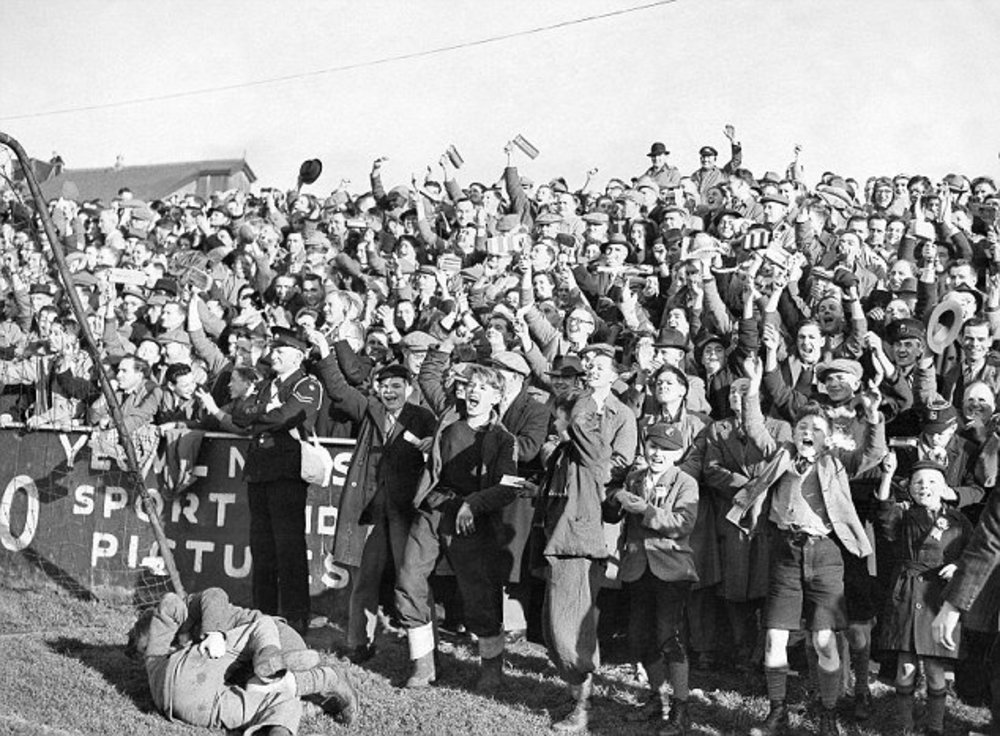
Yeovil cup run ended in the next round when they came up against a Manchester United side who were to finish runners-up to Portsmouth in the First Division that season.
Matt Busby`s United, who were the holders after winning at Wembley against Blackpool in 1947/48 beat them 8-0 at Maine Road with Jack Rowley netting five times, Ronnie Burke twice and Charlie Mitten once.
United went on to lose to Wolverhampton Wanderers in the semi-final, but Yeovil had made their mark on the world`s most famous knockout competition.
NUNEATON BOROUGH had reached the Third Round of the FA Cup back in 1949/50 as a Birmingham League side.
It wasn`t until 1966/67 that they made that stage of the competition again, this time as a Southern League Premier Division outfit who were to finish as runners-up to Romford at the end of the season under Dudley Kernick.
Nuneaton had to start at the First Qualifying Round stage and were handed a tricky away tie to West Midlands (Regional) League neighbours Atherstone Town.
Tricky on paper, but not, as it turned out, on the pitch as, despite falling behind to an early 3rd minute George Awde goal, Boro went on to hammer the Adders 6-1.
Billy Hails, Tommy Crawley and two from Tony Richards made it 4-1 at half-time and he went on to complete his hat-trick from the penalty spot in the second half, with Paul Cutler also getting in on the act.
That win earned Nuneaton a home tie against Midland League side Loughborough United at Manor Park in the Second Qualifying Round.
And this was to turn out to be another goal blitz by Kernick`s side in which Richards gave Boro a 7th-minute lead which Richard Kalisack quickly cancelled out.
And, just as at Atherstone, Boro fell behind after 25 minutes when Brian Metcalfe made it 2-1.
But that was as good as it got for the visitors, who ran in seven more goals with Richards completing a second successive hat-trick, Gerry Sweeney bagged a brace and singles came from Crawley, Cutler and Norman Ashe.
Southern Premier rivals Burton Albion came out of the hat first for the Third Qualifying Round, but a 63rd minute Paul Cutler goal eventually sealed victory for Boro.
The Fourth Qualifying Round paired Nuneaton with Cheshire League Macclesfield Town at Moss Rose.
This was a tough encounter in which defender Alan Jones equalised Carl Davenport`s 11th-minute opener for the Silkmen to earn a replay at Manor Park.
And a terrific crowd of 7,177 saw Norman Ashe grab two fine first-half goals. However, Boro owed a great deal to diminutive goalkeeper Fred Crump, who saved a Brian Fidler penalty when the score was 1-0 – Fidler went on to score Macclesfield`s second goal in the first-ever FA Trophy Final at Wembley four years later!
The win put Boro into the First Round Proper for the first time since 1954 but instead of a money-spinning tie against a League club, they were handed another very awkward-looking game away to Isthmian League side Wealdstone at Lower Mead.
The Stones were reigning FA Amateur Cup winners and had some excellent players in their ranks, such as Eddie Dilsworth, who Nuneaton would come up against on many occasions later with Chelmsford City and Kettering Town, but it was Richards again who found the target for the visitors, along with Paul Cutler to give them a 2-0 win.
Nuneaton were rewarded with a home tie against Third Division strugglers Swansea Town in the Second Round and a record crowd of 18,000 crammed into Manor Park.
Although the Swans were struggling at the time, they still had the likes of Welsh legend Ivor Allchurch in their side.
However, his silky skills were nullified by a really muddy pitch which made any sort of decent football extremely difficult and made a cup upset even more likely.
A Tommy Crawley header gave Boro a 22nd-minute lead and a 65th-minute own goal from defender Dennis Coughlin sealed the visitors fate.
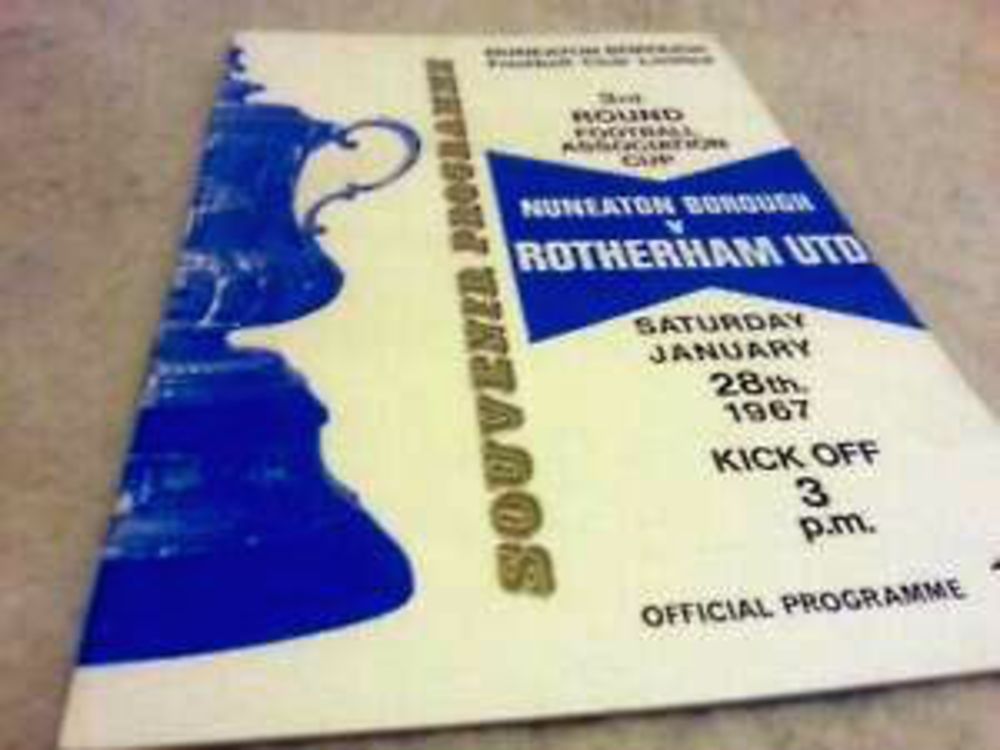
Conditions were little better when Nuneaton welcomed Second Division Rotherham United to Manor Park for the Third Round tie in front of an even bigger crowd of 21,118.
And another shock looked on the cards when Paul Cutler gave the home side a 19th-minute lead.
But the Millers equalised immediately after half-time through Dave Chambers and forced Boro to hold on in the end when their superior fitness began to tell on the heavy pitch.
The replay at Millmoor pulled a crowd of 22,930 is still discussed today by older Nuneaton supporters who witnessed it.
The hotly disputed goal came 4 minutes after the break when Harold Wilcockson`s shot looked like being tipped over the bar by Boro Keeper Fred Crump, who looked to have impeded and the ball ran down his arm and into the net.
Such was the confusion that some said it was an own goal, some that the scorer was Wilcockson and others that Les Chappell scored.
Boro, of course, protested strongly as the linesman had been flagging, but the referee allowed the goal to stand and Nuneaton`s FA Cup run came to a disappointing end.
In 1967/68 Southern Premier Division GUILDFORD CITY embarked upon a memorable FA Cup run.
After taking two attempts to beat Sussex County League Chichester City in the Fourth Qualifying Round, Guildford were leading 2-1 at Fourth Division Brentford in the First Round proper when the match was abandoned due to snow.
A 2-2 draw in the rearranged fixture saw 7,289 fans cram into Joseph’s Road to roar City on to a famous 2-1 victory in the replay.
A further 8,774 saw City fall narrowly to another Fourth Division outfit, Newport County, in the Second Round, but the heroes of that era, players like Tony Burge, who is still the club`s record goalscorer and long-serving Darby Watts – still the club`s record appearance holder with 632 games - will be remembered fondly as club legends.
KETTERING TOWN have one of the best FA Cup records as a non-League club and have regularly featured in the First Round onwards over the years.
However, one run, in particular, stands out and that was in 1968/69 which ended at the Third Round stage.
The Poppies have twice gone further than that though, losing at Charlton Athletic and Fulham respectively in Fourth Round ties in 1988/89 and 2008/09.
Back in 1968 under player-manager Steve Gammon, the former Cardiff City and Wales under-23 international midfielder, Kettering began at the First Qualifying Round stage.
And they could hardly have pulled a harder tie when they were paired with a Cambridge United side who would go on to win the Southern League Premier Division title later that season, with the Poppies down in ninth place.
Kettering were seeking some revenge as it was Cambridge who knocked them out of the competition at the Third Qualifying Round stage last season, winning 3-0 at the Abbey Stadium.
At least this year the tie was at Rockingham Road and, although not an inspiring encounter, Kettering did at least earn a little retribution, thanks to a Harry Walden penalty in a 1-0 win.
Monday`s draw paired the Poppies with a tricky away tie at Eastern Counties League side Soham Town Rangers.
It proved another tough assignment for the visitors, who scraped through with a goal just past the hour-mark from Ken Gully.
Their Third Qualifying Round opponents wouldn`t have far to travel as the Poppies were handed a home tie against neighbours Wellingborough Town, who at the time were members of the Metropolitan League.
The Doughboys were the underdogs but had some dangerous players – none more so than top scorer Howard Kettleborough.
He did manage to breach the home defence, but Kettering progressed comfortably enough 4-1 with Gully bagging another brace.
Atherstone Town, who would later become Southern League opposition for Kettering, came to Rockingham Road for a Fourth Qualifying Round tie as members of the West Midlands (Regional) League.
An own goal and a Mick Goodall effort saw Kettering earn a place in the First Round draw in unconvincing fashion.
And that draw could hardly have been worse for the Poppies as it pitched them away to Hampshire League minnows Waterlooville – another club they would eventually play on equal terms in future years.
It had taken Waterlooville three attempts to get past South Western League side Falmouth Town in the last round before winning a second replay at Exeter City 2-1.
And on their Jubilee Park ground, they proved a tough nut to crack, especially after they took the lead.
But another Gully goal and a fine solo effort from Barry Daldy saw Kettering make the long journey back to Northamptonshire 2-1 winners and into the Second Round.
Ears were tipped towards the radio as the draw was made and Kettering`s name came out first, which was the first piece of good news.
But they wouldn`t be hosting a Third or Fourth Division side – but a Dartford outfit who were languishing in the Southern League First Division and had pulled off a shock 3-1 win at home to Fourth Division Aldershot in the last round, so couldn`t be taken lightly.
The Darts, managed by Ernie Morgan, held the Poppies until 3 minutes into the second half when an unfortunate own goal by centre-half Alan Lillis broke the deadlock.
A second from Gully quickly followed and the visitors visibly wilted and Kettering ran in three more goals from Daldy, Dick Smith, and Harry Walden to make it a nap hand.
Reward for that emphatic win was a trip to Eastville to play Third Division Bristol Rovers.
The Poppies had lost 3-0 on the same ground against Rovers in the FA Cup back in 1951/52, but this time a battling, often backs-to-the-wall effort earned a replay, thanks to a goal from local centre-back Mick Reed.
It could have been another giantkilling act though, as in the dying embers of the game, a Mick Goodall piledriver produced a wonder save from Rovers` keeper Laurie Taylor, who was to prove a hero again in the second game at Rockingham Road.
The draw had already been made of course, so both sides were looking to travel to Burnden Park to take on four-time FA Cup winners Bolton Wanderers, then a struggling Second Division side.
And when Daldy gave the Poppies a 33rd-minute lead, the majority in the packed house of 9,000 were already dreaming of a trip north.
And in the 70th minute, Kettering were handed a fantastic chance to clinch that tie when Rovers centre-half Larry Lloyd, who would go on to win the European Cup twice with Nottingham Forest after starring with Liverpool, brought Daldy down to a penalty.
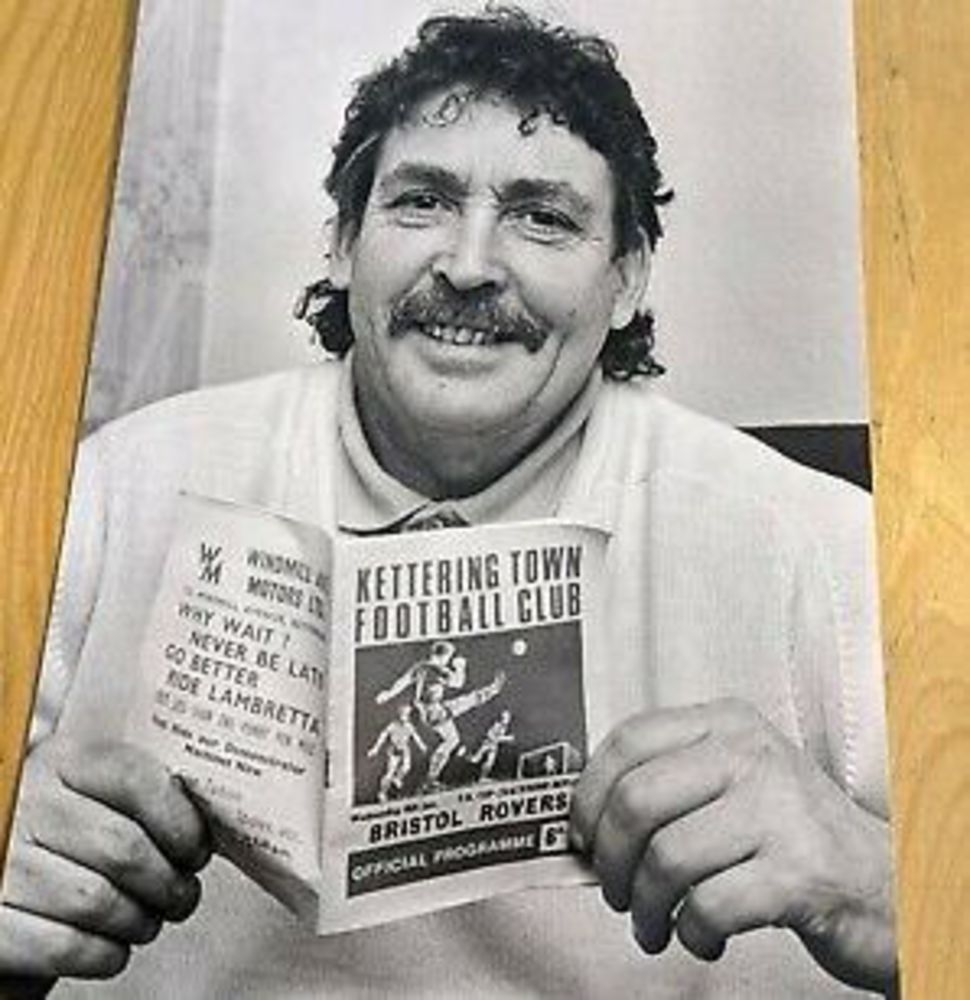
The normally reliable Walden (right) though had his spot-kick saved by Taylor and the tide turned in the visitors` favour.
Distinctly second best up until then in what was a thrilling tie, Rovers upped their game and the equaliser came in the 79th minute when the other centre-back, Stuart Taylor, headed past Bryan Harvey to make it 1-1 and extra-time loomed.
But right near the end of the game came the cruelest of winners for Rovers when Bobby Jones hammered a cross aimed at Ray Mabbutt, only for Poppies player-boss Steve Gammon, who had been immense all evening, to get in the way and the ball diverted off the top of his head past Harvey and the cup run was over.
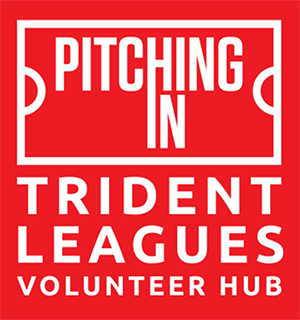
Most clubs are looking for volunteers. Find out more on the button below:
www.PitchingInVolunteers.co.ukAll the news and results in one place.
REGISTER